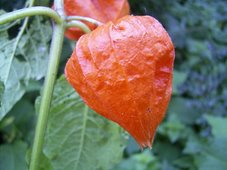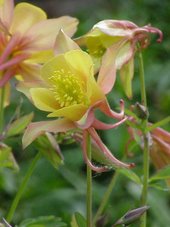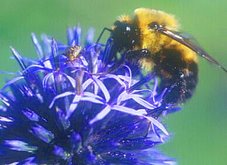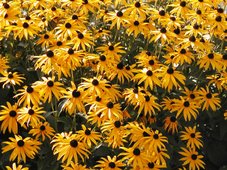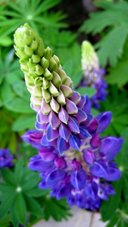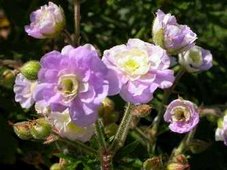 Mar E-mailed me this short fiction about a garden and its keeper. Thanks Mar! Hope you all enjoy it too; that it makes a little bright spot in your day, as it did mine! ( ... and yes, don't laugh! Mar and I have adjoining desks in our home office but routinely E-mail each other with tidbits we receive on-line.)
Mar E-mailed me this short fiction about a garden and its keeper. Thanks Mar! Hope you all enjoy it too; that it makes a little bright spot in your day, as it did mine! ( ... and yes, don't laugh! Mar and I have adjoining desks in our home office but routinely E-mail each other with tidbits we receive on-line.)__________________________
Carl was 86 years old. His church announced that the garden behind the pastor's house needed someone to care for it. So Carl volunteered to be the keeper of the garden. And just about every day he was back there, watering or weeding or tilling that little garden. This was not the kind of neighborhood one might choose to live in
today - it had changed over the years. It was a rough, inner-city neighborhood, dominated by gangs and violence. Yet it was where Carl lived.
One day Carl was working in the garden, when a gang of three young men spotted him, taunted him, ridiculed him, and pushed him around. But Carl never said anything, he simply smiled. As it was a hot afternoon, he gently asked if they would like a drink from his garden hose.
They laughed at him and pushed him down into the mud. Then they relieved him of his retirement watch and his wallet, leaving him on the ground and laughing as they continued down the street. The pastor saw the incident and rushed over to help Carl up. The old man picked up his hose, still gushing water, and continued his work.
"What are you doing?" asked the pastor.
Carl answered, "Aw, they're just punks. Maybe they'll wise up some day. I'm not going to let them keep me from the garden." A compassionate and gentle man, Carl was not prone to violence.
Something similar happened another time. Carl was again watering the garden when the young men spotted him. They insulted and derided him. He never answered back; never responded with anger. He just quietly continued his work. And, once again, he mentioned it was a hot afternoon and offered them a cold drink. They thought it was funny. They took the hose and this time doused Carl. They hosed him from head to foot. Then they left, still laughing. Dripping wet, the old man continued to water his garden.
Some weeks later, when Carl was again working in the garden, he heard a voice behind him. It startled him. As he turned around, he lost his footing and he fell back into a small evergreen shrub. Though unhurt, he had a bad leg and struggled to get up. Carl recognized the leader of the gang that abused him and prepared for the worst.
But this time the man said, "I'm not here to hurt you, old man. Here, let me help you up," and he extended his hand. "I've got something for you." Reaching into his pocket, he pulled out a crumpled paper bag. Carl reached in and found his retirement watch and his wallet. The young man continued, "It's all there, even the money."
Carl looked through the wallet until he found the picture of his wife, now dead now for several years. She was much younger, then. He asked, "Why are you doing this?"
The young man said, "I haven't been able to sleep very well, lately. I've been thinking about you, all these times we've come over here, and the things that we've said to you, and you never said anything back to us; the way we've treated you and you never treated us badly. I guess I feel bad about that, and watching you, I know I can do better, and I think I will do better." He continued, "I guess this is just my way of saying I'm sorry."
Carl never saw that young man again. He passed away that year about a week after Christmas. The pastor said something at the funeral about doing the best you can with your life. Make your garden as beautiful as you can, he said. Of course, he was talking about our lives, not actual gardens. But a young man who sat in the back of the church by himself heard those words.
When spring arrived, the pastor put an announcement on the bulletin board asking for a volunteer to take care of what was now called Carl's garden. In a few days, the young man from the funeral stopped by. The pastor recognized the gang leader, who said, "I believe that's my job, if you'll have me. I looked up to Carl. I respected him. I think, because of him, I'm becoming a different person. I'd like to take over that garden."
So he got the job of caring for Carl's garden. He worked on making some of those changes in his life, too. He went back to school. He graduated and eventually got married. He landed a job with real responsibility. And still every Summer he cared for the garden. He watered it, weeded it, tilled it.
After a few years, that church changed pastors. One day the young man came into the new pastor's office and announced, "I'm going to have to give up my job of caring for Carl's garden. You see, we've just had a new baby boy, and I want to spend a lot of time with him this summer."
The pastor smiled and said, "Oh, that's wonderful. That's marvelous! Congratulations. What are you going to name him?"
The man said, "Carl. I think we'll call him Carl."
 Last week, when Mar found those free salmon bricks on Kijiji, (to eventually become the small patio in front of our planter seat), the kind lady pointed to a small pile of another variety of bricks in another corner of her garage and asked if we had a use for them as well. If so, we could help ourselves to them.
Last week, when Mar found those free salmon bricks on Kijiji, (to eventually become the small patio in front of our planter seat), the kind lady pointed to a small pile of another variety of bricks in another corner of her garage and asked if we had a use for them as well. If so, we could help ourselves to them.




























































